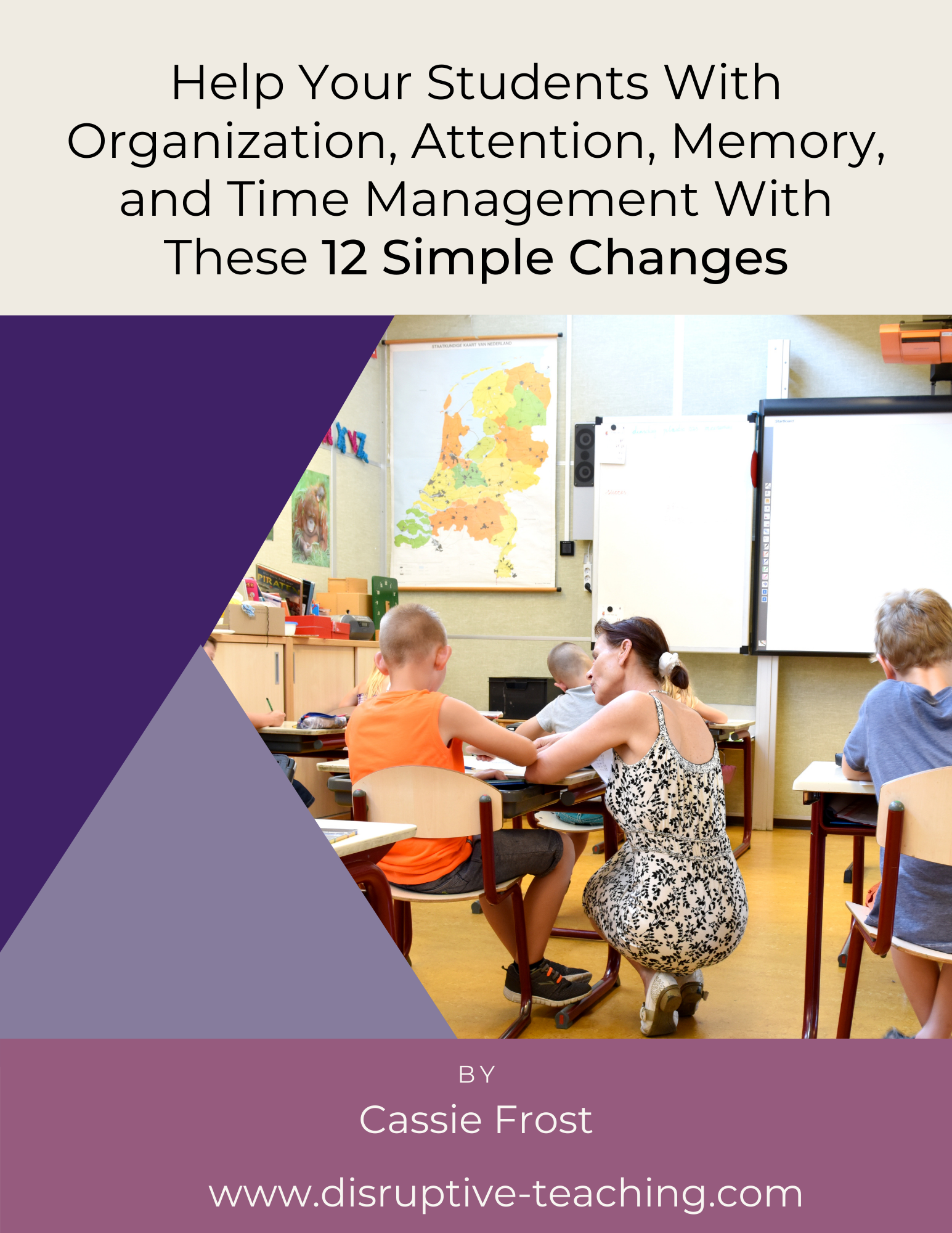Executive Function Skills By Age: What You Need To Know
Inside: Students are expected to come to class ready to learn but often struggle with the executive functioning skills required to focus, stay organized, and remember multi-step directions. Learn what skills you can expect from your students at each grade level and how you can practice these skills with your students.
Imagine for a moment a classroom filled with laughter. Bright colored posters hang on the walls, colored dots sit on the floor, and pictures are taped to drawers showing where the colored pencils get put away.
Imagine another classroom, a bit quieter, but with a lot of chatter. Posters still hang on the walls, but with fewer pictures and more words—a list of assignments written on the front board.
If I asked you to guess each of these classrooms’ grade levels, I think you would have a pretty good idea of students’ age in each room.
Why do these two rooms look so different?
As educators, we design our spaces and instruction to match the students’ age level.
Insanity is exhausting. My students were struggling with something called Executive Functioning.
Executive Functioning deficits tripped them up and caused them to struggle with the basics of school, which left them unable to focus on the academic tasks I desperately wanted them to learn.
When students are younger, we automatically provide more supports:
Posters and visuals
Colorful labels and stickers
Shorter activities and longer breaks
As students grow, we determine, often through habit and by viewing our fellow educators’ classrooms, some of these supports are no longer needed.
Where does this decision come from?
I would guess there are not any solid answers that pop into your head. Over time we tend to adjust our habits to what we think works best and based on common beliefs.
We need to prepare students for ________ (Insert grade level here)
“We need to prepare students for junior high.”
They won’t have these supports when they ________ (Insert non-school activity here)
“They won’t have these supports when they are on the basketball court!”
They won’t always have a ______ with them when they go into the real world (Insert any tool that helps a student)
“They won’t always have a calculator with them when they go into the real world.” -My high school math teacher was wrong. My cell phone has a calculator I use almost daily!
The most well-intentioned educators believe their primary goal is to make students independent and not rely on all of the extra supports they had the year previous. Over time, we have developed a pattern in a reduction in supports as students get older.
The question now arises.
What is an appropriate amount of support at each grade level?
While this varies from student to student and classroom to classroom, there are a few things that can help you make decisions about the supports you provide in your classroom.
Student executive functioning skills are the first qualities to inspect when deciding what support level should exist in a classroom.
For more information about Executive Functioning, check out the article “Improving Executive Functioning- What You Need To Know To Ensure Student Success.”
Executive Function Skills By Age
Just like reading and math, executive function skills grow and change over a child’s development.
Infant Development
During a child’s first years, they will learn organization skills, attention control and begin developing working memory.
Organization development occurs during matching games and as children learn objects belong in certain places.
Attention begins with the first stage of the attention hierarchy with focused attention (looking at one item). As the infant years progress, it moves into sustained attention (the child can pay attention to the same thing for some time).
Memory shows up in games such as hide-and-seek and peek-a-boo.
Many students struggle in this same way. They want to remember, they have every intention of completing the assignment. But their brain may be thinking of so many things, their memory cannot keep up.
In addition to ADHD, many other medical conditions can cause students to struggle with memory. Most of these do not have a simple “fix”.
But you can increase their ability to remember by providing visuals and implementing tools to support attention.
So Much To Learn In Early Childhood
Early childhood is the period during which time management skills begin to emerge. Children begin to follow picture schedules and practice waiting.
Often, we offer the most visual supports for students in school, with calendars, posters, schedules, etc., during this time.
During early childhood, organization skills snowball as students are expected to begin to clean up after themselves and solidify the concept items have places they belong.
Children start to follow multiple-step directions and can sustain attention for more extended periods.
How To Practice Executive Functioning Skills With Early Childhood Students:
Provide visual cues for routines and clean-up and help students be independent in these things.
Encourage focus during preferred and fun tasks and slowly increase the length of time.
Engage in games and activities that involve sorting and labeling.
Growth and Change- Elementary School
Elementary school is a time of enormous growth for the development of executive functioning skills.
However, it is essential to remember not all students will develop the skills simultaneously. Medical or environmental conditions can change the rate these skills develop. Because of this, many students will need support for more extended periods. Additionally, some students may develop skills faster than others.
Time management develops throughout these years, and students can differentiate required tasks from non-required tasks.
Students at these levels will need to continue to have support in planning for longer tasks and breaking tasks apart, as they will not yet have developed the skills to adjust working speeds and effectively estimate the time required to complete tasks.
Students will begin to gather materials for routine activities and keep track of tasks with checklists. These organizational skills develop faster when there is direct instruction in how to complete them.
Memory develops to be a much more consistent resource during these years, with students learning to be independent with group activities and apply background knowledge to new activities.
Attention at this level will begin to increase to include selective attention, allowing students to pay attention to one thing without distraction, and alternating attention, allowing them to switch focus between tasks.
The rate of attention skill acquisition is dramatic in most students, causing students who struggle to fall behind.
During the elementary years, the demand for flexible attention increases exponentially, requiring students to switch between tasks, often many times within one class period.
Students who struggle with attention during these years will find themselves struggling as they move into their teenage years.
How To Practice Executive Functioning Skills With Elementary Students:
Provide visuals for routines and calendars.
Practice and model using calendars and checklists.
Review and model the steps of multi-step activities.
Speak your thoughts as you’re planning a project or activity so students can learn from your process.
Frozen Feet- A Story Of Teenagers And Executive Functioning
“I promise we will keep you alive until your brain turns back on.” While this sounds like a rather funny statement, this is something we used to tell our daughter.
We were not implying her brain was not great. But it did help us explain to her why she sometimes did silly things.
Like walking outside for the bus in the middle of the winter.
With:
A jacket
A hat
Gloves
Her backpack
And no shoes.
During the early teenage years, a student’s body is going through many changes, and their focus turns to friendships and social interactions much more than during the elementary years.
This causes even the most solid student to sometimes struggle with things they may have never had issues with in the past.
The good news is we were able to keep her alive and without frost-bitten feet until she turned 15, and it seemed like slowly; the silly little things began to decrease.
During these years, as educators, we move into high-speed to prepare our students for the “real world.”
Our students develop organizational, attention, time management, and memory skills needed in their future education and careers.
This makes it easy to take the stance that we should be treating them as if they have good skills in all of these areas already.
Which, as my daughter’s cold feet demonstrate, isn’t necessarily true.
These are the years to help our students identify their strengths and weaknesses regarding executive functioning and help them practice new skills or find tools to support lagging skills.
How To Practice Executive Functioning Skills With High School Students:
Provide options for organizational tools and methods, teaching a variety of high and low-tech methods.
Provide visuals and model the steps of multi-step activities and projects.
Encourage students to leave ‘bread crumbs’ for themselves in the form of notes, pictures on their cell phones, or drawings to help remember and organize their to-dos.
My Confession
That classroom with the colored posters, labels, and floor markers isn’t so far off from the way my office looks now.
As I look around, I see many executive functioning supports that perhaps are a bit less colorful than my elementary classroom but just as valuable.
Post-it notes
Daily calendar
Labels for drawers and folders
A checklist of things I have yet to get to
What you need to know about Executive Functioning skills is they grow slowly over time, but they do not all develop at the same rate, and there is no requirement to take away all of the supports that benefit a student.
Download Your Free Printable
Join 141 educators who have used this checklist to improve executive functioning supports in their classrooms.
Sign up to receive this Checklist to 12 Simple Changes in your inbox and sign up for my mailing list full of tips to help students who struggle with organization, time management, memory, and attention.
Don’t worry- I don’t like spam either.
When you sign up for my mailing list you will receive short emails full of simple tips and this easy-to-follow checklist, but your email will never be shared.
Follow these steps to make sure your next lesson has the supports in place to support your students:
Download the worksheet. You will get the free printable and will join my mailing list full of timely executive function tips and printables.
Print a few copies. Leave them sitting on your desk, in your classroom, any place you stop to reflect.
When you are planning a lesson or reflecting on a previous period, pick up the Executive Functioning Inventory. Pick up a fun pen and fill out the worksheet to identify areas that can be adjusted, adapted, or supported.
Teach. With confidence, knowing you are supporting all students.
















